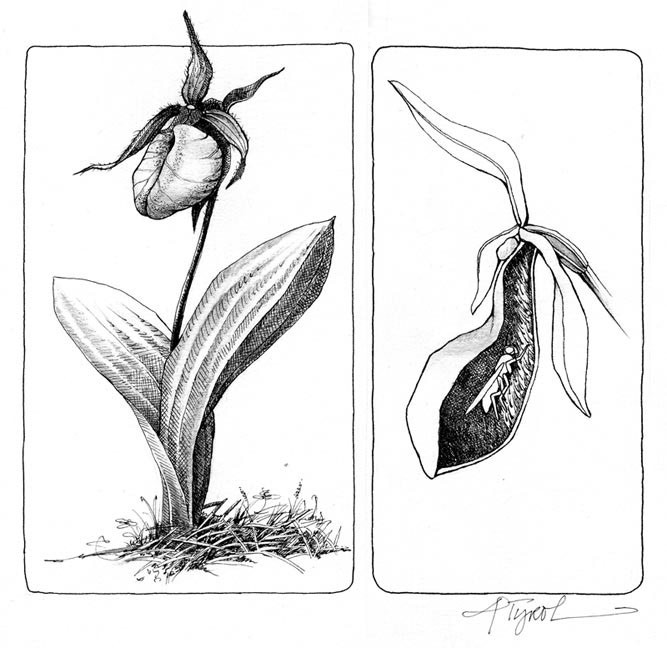
One of the pleasures of the brief northern spring is moseying-about in back forties to learn what birds are arriving, what insects are emerging and what flowers are blooming. And among the most rewarding finds this time of year are the always-uncommon, sometimes-very-rare, wild orchids. These exquisite yet bizarre flowers are members of one of the largest and most widespread groups of plants on earth. The orchid family has 15,000 to 30,000 species, 5 to 10 percent of all species of flowering plants, yet, paradoxically, that family includes some of the rarest plants in North America.
While most orchids are tropical and epiphytic (growing on trees), the 200 or so species in temperate North America are largely terrestrial; some are strictly boreal in distribution. In Vermont and New Hampshire, most native orchids are uncommon, at the very least, while many are labeled threatened or endangered. Their status is tenuous largely because the habitats in which they live are themselves rare. In the Northeast, for example, more than half of the 60 known species are restricted to peatlands (acidic bogs and more-neutral fens).
The most common orchid species in northern New England—though never common in the sense of dandelions or maples—is the moccasin flower, with its pink or white ‘lady’s-slipper’ blossom. It prefers acidic softwoods, while other forest-dwelling species, such as the rattlesnake plantains and showy orchis, are the less dramatic, less seen dwellers of mixed forests. In the special, restricted landscapes of peatlands, white bog orchid is a regular inhabitant, while grass pink, rose pogonia, dragon’s mouth and showy lady’s slipper – all with pink or reddish blossoms – are significantly rarer, growing almost exclusively in open, less-acidic fens. Several species are imperiled by even more restricted habitats, such as the delicate fairy-slipper of a few northern cedar swamps, ram’s-head lady’s slipper in certain limestone-rich locales, and the small whorled pogonia that grows in just a few acidic woodlands. For flower lovers, the sight of these orchids often etches into permanent memory.
With their highly evolved flowers, nearly all orchids are utterly dependent on insects for their perpetuation. Unlike many other groups of flowering plants, in orchids the pollen is clumped in a sticky wad – known as a pollinium – that is locked or hidden deep within the flower where winds cannot bear it away and most insects cannot reach it. The pollinium can be removed only by adhering to a specific pollinator, usually an insect, thereby hitching a ride to another flower. The showy, colorful, and often-strongly scented blossom attracts the appropriate species, one that is able to navigate the flower’s unique anatomy and effect pollination. In many tropical species, the deception and trapping is elaborate; some flowers even mimic the female insect, luring the male into false anticipation of copulation!
Our native New England orchids, while not to this extreme, have their own ways of luring, deceiving and entrapping insects. In the moccasin flower, for example, a bee enters through a slit in the ‘slipper,’ likely drawn to the fragrance of the hairs lining the inside. Finding no nectar there, the bee leaves, not by the slit (which is not visible from the inside) but through an opening at the top where it rubs against the pollinium. The pollinium sticks to the bee and is carried to a new flower, where cross-pollination occurs.
The grass pink has other trickery. Its flower’s big lip projects straight up, is hinged at the base, and has many stamen-like filaments. But the flower has neither stamens nor nectar, and when the duped visitor – usually a bee of the right size and weight – lands on the lip in anticipation of reward, the lip folds inward at the hinge and the bee drops upside down onto the pollinium. The bee struggles out, the pollinium sticking to its back, flies to another flower, and repeats the procedure, this time transferring the pollinium to the new flower.
Later in the summer, orchid seeds are numerous—often thousands per flower – and they are tiny and light enough to become windborne like pollen. The seeds are so small mainly because they lack endosperm, the food normally stored for the developing embryo. Instead, the poorly organized orchid embryo obtains its food from a fungus that invades each seed, an association that continues in the adult orchid, with the fungus growing and taking up residence in the roots.
Probably due to their inextricable tie to these fungi, as well as their dependence on such specific habitats, orchids are notoriously sensitive about their living conditions, and unpredictable bloomers even when growing in what seem to be the most suitable places. They may be prolific one year but the next not a flower is to be found. Or they may suddenly reappear where they have been absent for decades. But most troubling is their outright loss, either due to destruction of their habitats or plundering by collectors for their beauty, delicacy, and rarity.
See one, and consider yourself blessed.


Discussion *